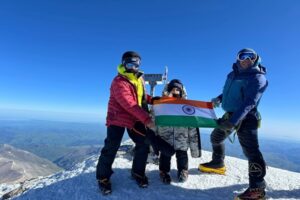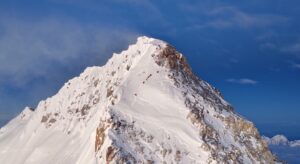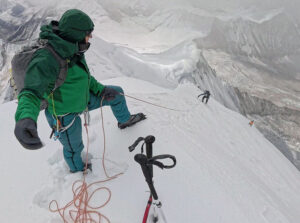The effects of climate change and the increasing pressure of human action on natural spaces was the topic of a remarkable article in the Nepali times about Gokyo village and the lakes in the Solokhumbu district. The author, Ang Rita Sherpa, is a Gokyo native and chairman of Partners Nepal, a local nonprofit that helps Himalayan communities keep or restore their nature and culture. In the piece, Ang Rita reflects on how much his childhood playground has changed because of tourism.
Gokyo is one of the most popular spots for trekkers in the Everest region, thanks to its spectacular views of nearby Cholatse, Thamserku, Kangtega and the sheer South Face of Cho Oyu. Like a river of ice, the Ngozunpa Glacier — at 36km, the longest in Nepal — flows just above the village. One level below the lateral moraine, a green valley and a system of turquoise lakes spread out.
Between Cho Oyu and Cholatse rises Gokyo-Ri, a 5,357m peak whose straightforward climb makes it a perfect goal for trekkers wanting to notch an (admittedly humble) Himalayan summit. It is also many climbers’ first acclimatization peak before they head for more ambitious goals. Thirty-five years ago, the village of Gokyo, located on the shore of the area’s biggest lake, was barely a cluster of yak herders’ huts. Today, it features over a dozen buildings, mainly modern lodges.

Gokyo back in 1985 (left) and now. Photos: Ang Rita Sherpa
Compared to the pastoral image of Gokyo he remembered from his childhood, Ang Rita states that the place has degraded in the last three decades. A pair of pictures, past and present, corroborates the changes. The contemporary image shows the new buildings and the dramatically receding glacier. Like all Himalayan glaciers, the Ngozunpa has shrunk, and a six-kilometre-long lake, not visible in the photo, has pooled on its surface.
The problems that the author lists, however, are not specific to Gokyo. Most of them apply almost everywhere in the Himalaya. Climate change, in particular, affects mountain areas around the world.
As Ang Rita admits, yak shepherds have reduced size of their herds because of lack of grass. The disappearance of the once-ubiquitous dwarf junipers has mostly ended cooking over wood fires; nowadays, gasoline is the most common fuel. Waste management is far from perfect, and some of this rubbish ends up in the sacred lakes, which are enlarging from glacier melt.
The situation in Gokyo is an example of how difficult it is to balance the benefits and drawbacks of progress in fragile ecosystems, and how global problems affect local areas.

The glacier covered in moraine debris. Photo: Carlos Soria
To add to Ang Rita’s local perspective, ExWeb spoke to Carlos Soria for a climber’s point of view. The 81-year-old Spaniard has summited 12 of the 8,000’ers. Recently, he’s become known for his obsessive attempts on Dhaulagiri, whose summit has eluded him 11 times.
In his long life of mountaineering, Soria has seen landscapes change around the world. He first visited Gokyo about a decade ago. He often acclimatizes up the Khumbu Valley before heading west to Dhaulagiri, and he always takes the side trail from Namche to spend a day in Gokyo.

As glaciers shrink, Himalayan lakes expand. Photo: Carlos Soria
Soria points out that many lodge owners and staff live in the area only during the trekking season, thus softening the impact. “I know some foreigners would like to see Nepal and its mountains isolated from any sign of progress, but how can we teach Nepali people lessons in sustainability, when we [Westerners] have over-exploited all our natural resources and polluted the whole planet?”

Carlos Soria with the owner of the Gokyo lodge he regularly stays in.
The Spaniard recalls how he used to swim in the pools by a creek near his home in Madrid, before those open spaces were engulfed by the growing city, and the creek disappeared under a new highway.
“I wish Gokyo represented the worst environmental problem in the world,” he says. “It would mean we still had a beautiful planet. Sure, there are some lodges, but it’s hardly crowded compared to the rest of the Khumbu. The place is still magical.”






